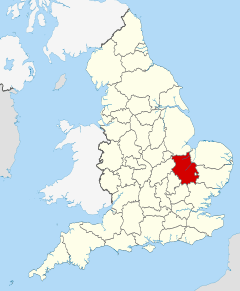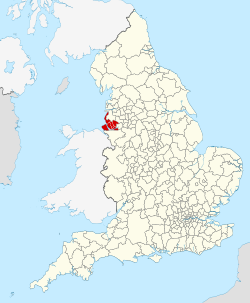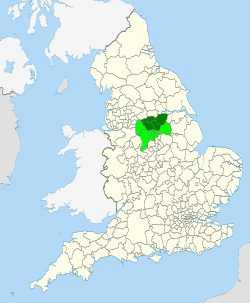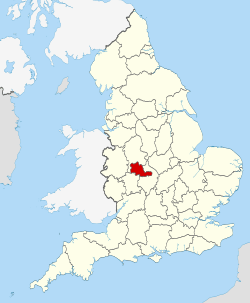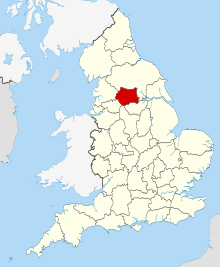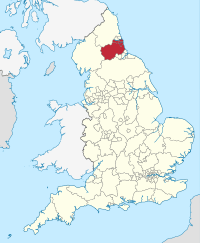Combined authority
A combined authority is a type of local government institution introduced in England outside Greater London by the Local Democracy, Economic Development and Construction Act 2009.
| Combined Authorities | |
|---|---|
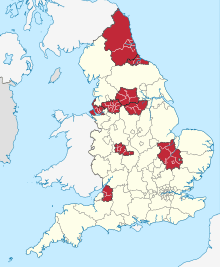 | |
| Category | Metropolitan area |
| Location | United Kingdom |
| Number | 10 |
| Additional status | City regions |
| Government | Board of Indirectly-elected council leaders
Metro Mayors (9) No Mayor (1) |
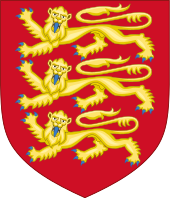 |
|---|
| This article is part of a series on the politics and government of England |
|
Elections |
|
|
|
|
There are currently ten such authorities, with the Greater Manchester Combined Authority established on 1 April 2011, four others established in April 2014, two in 2016, two more in 2017 and one in 2018. Combined authorities are created in areas where they are considered likely to improve transport, economic development and regeneration. Combined authorities are created voluntarily and allow a group of local authorities to pool appropriate responsibility and receive certain delegated functions from central government in order to deliver transport and economic policy more effectively over a wider area.
History
Following the abolition of metropolitan county councils and the Greater London Council in 1986, England had no local government bodies with strategic authority over the major urban areas of the country. In 1999, following a successful referendum, the Labour government created a strategic authority for London (the Greater London Authority), but no bodies were established to replace the metropolitan county councils outside London. The Blair government instead pursued the idea of elected Regional Assemblies, although following an unsuccessful referendum in 2004 in the most positive region – the North East – this idea had few proponents. The idea of city regions was proposed subsequently.
In October 2010 the Coalition Government introduced measures to replace Regional Development Agencies, which were described as inefficient and costly.[1] They were replaced with local enterprise partnerships, voluntary groups with membership drawn from the private sector with local authority input.
Earlier in 2010 the Government accepted a proposal from the Association of Greater Manchester Authorities to establish a Greater Manchester Combined Authority as an indirectly elected top-tier strategic authority for Greater Manchester.[2] Following the unsuccessful English mayoral referendums in 2012, combined authorities have been used as an alternative means to grant additional powers and funding as part of 'city deals' to metropolitan areas. In 2014, indirectly elected combined authorities were established for the metropolitan counties of South Yorkshire and West Yorkshire, and two combined authorities were established which each covered a metropolitan county and adjacent non-metropolitan districts: the Liverpool City Region Combined Authority for Merseyside and the Borough of Halton unitary authority, and the North East Combined Authority for Tyne and Wear and the unitary authorities of County Durham and Northumberland. In 2016 a combined authority was formed for the metropolitan county of the West Midlands, so that all metropolitan counties are now covered by combined authorities.
The first combined authority that does not cover a metropolitan county was Tees Valley, formed in 2016. It covers the area of the former county of Cleveland (now four unitary authorities in the ceremonial counties of Durham and North Yorkshire), together with the unitary authority of Darlington. Two further combined authorities were formed in 2017: West of England, comprising Bristol and two of the three adjacent unitary authorities in Gloucestershire and Somerset; and Cambridgeshire and Peterborough.
Legislation
The Local Democracy, Economic Development and Construction Act 2009 allowed for certain functions over transport to be delegated from central government. The Localism Act 2011 allowed additional transfers of powers from the Secretary of State for Communities and Local Government and gave combined authorities a general power of competence.[3][4] The powers and functions to be shared are agreed by the metropolitan district, non-metropolitan district, non-metropolitan county or unitary authority councils.
In 2014 the government consulted on changes to the legislation governing combined authorities. Proposed changes included extending the legislation to Greater London, Wales and Scotland.[5] The Cities and Local Government Devolution Act 2016 received Royal Assent on 28 January 2016.[6] The act allowed for the introduction of directly elected mayors to combined authorities in England and Wales with powers over housing, transport, planning and policing.[7]
Powers and functions
The combined authority is a legally recognised entity able to assume the role of an integrated transport authority and economic prosperity board. This gives the combined authority the power to exercise any function of its constituent councils that relates to economic development and regeneration, and any of the functions that are available to integrated transport authorities. For transport purposes combined authorities are able to borrow money and can levy constituent authorities.
Combined authorities are encouraged to borrow from European institutions for social and environmental schemes which meet EU objectives. Loans are made with conditions attached which further EU policies. By 2015 Greater Manchester CA had agreed loans from the European Investment Bank which topped £1 billion,[8] with similar liabilities to the Treasury and private business.
Process of creation or amendment
Combined authorities consist of two or more contiguous English local government areas. The creation of a combined authority is voluntary and all local authorities within the area must give their consent before it can be created.[9] The local authority of any district of England outside Greater London can join a combined authority, and a county council can become part of a combined authority even if only some of the non-metropolitan districts that make up the county are within the combined authority area. A local authority may only belong to one combined authority.[10]
There are three stages to the creation or amendment of a combined authority. Firstly a review must be undertaken to establish the likelihood that a combined authority would improve:
"...the exercise of statutory functions relating to transport in the area, the effectiveness and efficiency of transport in the area, the exercise of statutory functions relating to economic development and regeneration in the area, and economic conditions in the area."
— Local Democracy, Economic Development and Construction Act 2009, Part 6[11]
On completion of the review the local authorities produce and publish a proposed scheme of the combined authority to be created, including the area that will be covered, the constitution and functions. This will include details of membership of the authority, remuneration, and how meetings will be chaired and recorded. Following a period of consultation and subject to the approval of the Secretary of State for Communities and Local Government, the combined authority is formally created, dissolved or altered by a statutory instrument.
Existing combined authorities
Following the unsuccessful English mayoral referendums in 2012, new combined authorities were encouraged as an alternative structure to receive additional powers and funding as part of 'city deals'.[12] The combined authorities that have been created are as follows.[13]
Proposed combined authorities
Several additional combined authorities have been proposed:
| Name | Status |
|---|---|
| Cheshire and Warrington | Proposals by Cheshire East, Cheshire West and Chester, and Warrington underwent a public consultation in Summer 2017[23] but government permission was still being sought in Spring 2020.[24] |
| Cumbria | Original proposal failed in 2017.[25] A subsequent attempt for a single unitary authority failed in 2019,[26] leading to a new proposal for a combined authority in late 2019, alongside replacing the two-tier system with two unitary authorities.[27][28][29] |
| Dorset | A combined authority was proposed by the county's nine constituent councils, and is being considered by the two unitary councils (Dorset and Bournemouth, Christchurch and Poole), which replaced them in April 2019.[30][31] |
| East Midlands | There has been support from several council leaders for an East Midlands for a combined authority (in response to the West Midlands), with discussions to follow on whether a directly-elected mayor would be implemented, and on the future of the existing boroughs.[32] The leaders of seven Leicestershire councils wrote in 2020 to the Secretary of State for Housing, Communities and Local Government, who gave support.[33][34] |
| Essex/South Essex | A proposed devolution deal was narrowly voted against in 2016,[35] but re-emerged in 2020. A separate deal was also proposed for a "South Essex" Combined Authority, covering Southend, Thurrock, Basildon, Castlepoint, Brentwood and Rochford. The whole Essex plan also suggested forming four new unitary authorities, whilst the South Essex plan favoured retaining the current status.[36][37][38] The Minister for Regional Growth and Local Government stated in a letter that he did not favour the plan for a South Essex Combined Authority, but would be willing to discuss it.[39] |
| Greater Brighton | 7 councils in Sussex including Brighton and Hove have an economic board which coordinated development, skills and collaboration between councils. It is part of a long-term ambition to create a combined authority[40][41] |
| North Yorkshire | After the government rejected the One Yorkshire Proposal (see below), despite some continued support, a North Yorkshire alternative has been proposed (also called York and North Yorkshire[42]). |
| Heart of the South West | Proposed by councils in Devon and Somerset. As of 2017, talks between local councils ongoing, combined authority model approved in principle.[43] Discussions were continuing as of early 2020.[44] |
| Hull and East Riding | After the government rejected the One Yorkshire proposal (see below), despite some continued support, a Hull and East Riding alternative has been proposed.[45] |
| Lancashire | A proposal for Lancashire failed in 2017.[46] Council leaders agreed to the concept in June 2020,[47] with suggestions of reducing the number of districts into three unitary authorities,[48] or implementing a single unitary authority instead of a combined authority. |
Proposals not implemented
Proposals for a number of combined authorities have not progressed due to lack of the required approval from some participating local councils. Some proposals have seen revivals, for example in Cumbria.
| Name | Development |
|---|---|
| East Anglia | A plan for a combined authority covering the entire East of England region including Norfolk and Suffolk as part of an "Eastern Powerhouse", similar to the Northern Powerhouse.[49] The devolution deal was rejected by Cambridgeshire County and Peterborough City Councils. The original plan for separate devolution deals for Cambridgeshire and Peterborough and Norfolk and Suffolk was eventually agreed, although the latter was later scrapped (see below).[50] |
| Leicestershire | Leicestershire County Council proposed a combined authority in 2015,[51] but by 2018 this had been replaced with a proposal for a wider East Midlands authority (see above).[52] |
| Greater Lincolnshire | A plan for a Lincolnshire devolution was proposed, which would have included all constituent boroughs as well as the County Council.[53] The proposal failed in 2016 after constituent councils voted against it,[54] but is currently being included in plans for a wider East Midlands proposal (see above).[32] |
| Heart of Hampshire | Alongside a proposal for a Solent Combined Authority in the south of the county (see below), a separate proposal was put forward for a combined authority covering the remaining districts. This would have included Basingstoke and Deane, Hart, New Forest, Rushmoor, Test Valley and Winchester.[55] Alongside the Solent proposal, this later failed due to disagreements and the likelihood of the constituent authorities being reorganised.[56] |
| Norfolk and Suffolk | Original proposal was for a Norfolk and Suffolk Combined Authority, before being replaced with an East Anglia proposal including Cambridgeshire and Peterborough. The East Anglia plan failed, reverting to the original two plans. Whilst the Cambridgeshire and Peterborough plan succeeded, the Norfolk and Suffolk plan failed, with King's Lynn and West Norfolk Borough Council voting to reject the deal, and Norfolk County Council cancelling a subsequent planned meeting on the topic.[57] |
| North Midlands | A combined authority was proposed by Derbyshire and Nottinghamshire in 2016. South Derbyshire District Council, High Peak Borough Council, Amber Valley Borough Council and Erewash Borough Council all voted to reject the proposal, and Chesterfield Borough Council decided to sign up to the South Yorkshire Combined Authority instead.[58] In July 2016, it was reported that the North Midlands devolution deal had collapsed.[59] An East Midlands Combined Authority has subsequently been proposed (see above). |
| One Yorkshire | A proposal for a single Yorkshire Combined Authority, dubbed One Yorkshire, has been proposed for some time, but has failed to gain government support, being rejected in 2019.[60] The proposal has support from 18 of the 20 Yorkshire councils, with Sheffield and Rotherham both preferring the South Yorkshire alternative. The Mayor of the Sheffield City Region, Dan Jarvis, also supports a One Yorkshire proposal.[61][62][63] Whilst support remains for One Yorkshire, proposals are being discussed concerning York and North Yorkshire, and East Yorkshire (see above).[64][65][66] Some support has continued despite these alternative proposals.[63][67] |
| Solent | A proposal was made for a combined authority covering South Hampshire and the Isle of Wight. As well as the Isle of Wight, this would have included the unitary authorities of Southampton and Portsmouth, alongside Eastleigh, Fareham, Gosport and Havant. The proposal was first made in 2016, but was rejected by the government.[68] Discussions continued, but eventually the plan was rejected by the Isle of Wight Council.[69][70] See also Heart of Hampshire above, a proposal for the remainder of Hampshire. |
References
- "Local Enterprise Partnerships white paper" (PDF).
- "John Denham – Greater Manchester to be country's first ever Combined Authority". The National Archives. The Department of Communities and Local Government. 31 March 2010. Archived from the original on 4 May 2010. Retrieved 15 November 2015.
Historic plans for the country's first ever Combined Authority covering the whole of Greater Manchester to drive locally the region's economic growth were launched by Communities Secretary John Denham today.
- "A plain English guide to the Localism Act" (PDF). Department for Communities and Local Government. November 2011. Retrieved 15 December 2015.
- "Combined Authorities" (PDF). House of Commons Library. 9 October 2015. Retrieved 15 December 2015.
- Marrs, Colin (11 September 2014). "London seeks combined authority powers". Room 151: Local Government Treasury, Technical and Strategic Finance. Retrieved 2 June 2015.
- "Bill stages — Cities and Local Government Devolution Act 2016". Parliament of the United Kingdom. Archived from the original on 5 March 2016. Retrieved 12 March 2016.
- "Cities and Local Government Devolution Act 2016". The Stationery Office. Retrieved 12 March 2016.
- "Search engine".
- "Economic prosperity boards and combined authorities: Consultation on draft statutory guidance" (PDF). Archived from the original (PDF) on 24 August 2012. Retrieved 11 August 2012.
- "Combined Authorities Briefing: Stronger Together?". 5 July 2012. Archived from the original on 3 August 2012. Retrieved 11 August 2012.
- "Local Democracy, Economic Development and Construction Act 2009". Retrieved 11 August 2012.
- Sergeant, Mike. "Six biggest English cities get extra powers – BBC News". Bbc.co.uk. Retrieved 7 September 2015.
- "Cities' economic power unlocked in radical power shift". 5 July 2012. Retrieved 11 August 2012.
- "Population dynamics of UK city regions since mid-2011". Office for National Statistics. 12 October 2016.
- "The Cambridgeshire and Peterborough Combined Authority Order 2017", legislation.gov.uk, The National Archives, SI 2017/251
- "The Greater Manchester Combined Authority Order 2011". Retrieved 11 August 2012.
- "The Halton, Knowsley, Liverpool, St Helens, Sefton and Wirral Combined Authority Order 2014".
- "The Barnsley, Doncaster, Rotherham and Sheffield Combined Authority Order 2014".
- "The Tees Valley Combined Authority Order 2016". Statutory Instrument No. 449 of 29 March 2016.
- "The West of England Combined Authority Order 2017", legislation.gov.uk, The National Archives, SI 2017/126
- "The West Yorkshire Combined Authority Order 2014".
- "The Durham, Gateshead, Newcastle Upon Tyne, North Tyneside, Northumberland, South Tyneside and Sunderland Combined Authority Order 2014" (PDF).
- "Warrington to join Cheshire devolution bid". BBC News. 14 February 2017. Retrieved 5 March 2017.
- Andy Bounds (11 March 2020). "£38m a year for a greater West Yorkshire". Financial Times.
- "Cumbria's rejection of devolution deal costing Copeland millions of pounds, says mayor". News and Star. Retrieved 6 August 2020.
- "Shake-up to make Cumbria a single authority is 'dead in the water'". Times and Star. Retrieved 6 August 2020.
- "Copeland mayor calls for combined authority for Cumbria". In Cumbria. Retrieved 6 August 2020.
- "Minister's ambition for Cumbria devolution by May 2021". In Cumbria. Retrieved 6 August 2020.
- "Cumbria County Council could be split in two". The Mail. Retrieved 6 August 2020.
- "Speed up Dorset combined council plan, MP urges". BBC News. 17 January 2017. Retrieved 5 March 2017.
- "New Dorset unitary councils consider combined authority". BBC News. 18 January 2019.
- Orton, Amy (5 May 2018). "What you need to know as plans revealed for 'super council'". leicestermercury. Retrieved 5 August 2020.
- "First steps taken towards East Midlands Combined Authority | TheBusinessDesk.com". East Midlands. 29 February 2020. Retrieved 5 August 2020.
- Pritchard, Jon (11 December 2018). "Plan to create 'super council' in Nottinghamshire shelved". nottinghampost. Retrieved 5 August 2020.
- "Council leaders in Essex vote against elected mayor with authority over south Essex". Thurrock Gazette. Retrieved 6 August 2020.
- Reporter, Steve ShawLocal Democracy (4 August 2020). "Councils could be completely reshaped under plans being put together by Essex County Council". Yellow Advertiser. Retrieved 6 August 2020.
- Shaw, Steve (23 July 2020). "Anger over secrecy behind plans to create a combined authority for South Essex". Yellow Advertiser. Retrieved 6 August 2020.
- Reporter, Staff (16 July 2020). "Councils lay out vision for the future of South Essex under combined authority". Your Thurrock. Retrieved 6 August 2020.
- "No Combined Authority for South Essex say local MPs". Leigh Times. Retrieved 6 August 2020.
- "Greater Brighton City Deal" (PDF). Retrieved 9 August 2020.
- "Agenda item - Update on Greater Brighton Devolution Bid". present.brighton-hove.gov.uk. Brighton and Hove City Council. 31 January 2017.
- Services, Web. "York and North Yorkshire devolution". City of York Council. Retrieved 7 August 2020.
- Andy Keeble (17 January 2017). "Councils are 'keeping a foot in the door' on Devon and Somerset devolution deal". North Devon Gazette. Retrieved 5 March 2017.
- Clark, Daniel (27 January 2020). "New plans to ensure the voice of Great South West powerhouse gets listened to". devonlive. Retrieved 6 August 2020.
- Young, Angus (12 March 2020). "Hull and East Riding council leaders back diluted devolution deal". hulldailymail. Retrieved 7 August 2020.
- "Norfolk and Suffolk elected mayor plans scrapped". BBC News. 18 November 2016. Retrieved 14 January 2017.
- "Place North West | Leaders unite over Lancashire combined authority". Place North West. 16 June 2020. Retrieved 5 August 2020.
- "Lancashire councils face abolition in shake-up". BBC News. 29 July 2020. Retrieved 5 August 2020.
- "'Eastern Powerhouse' announced in budget". BBC News. 16 March 2016. Retrieved 6 August 2020.
- "Devolution between Peterborough and Cambridgeshire to be discussed after widespread city council opposition to East Anglian authority". www.peterboroughtoday.co.uk. Retrieved 7 August 2020.
- "Combined authority proposals | Leicestershire County Council". www.leicestershire.gov.uk. Retrieved 7 August 2020.
- Pritchard, Jon (11 December 2018). "Plan to create 'super council' in Nottinghamshire shelved". nottinghampost. Retrieved 7 August 2020.
- "Devolution deal in doubt after no vote". BBC News. 20 October 2016. Retrieved 7 August 2020.
- "Scrapped: Lincolnshire's £450m devolution deal no more". The Lincolnite. 11 November 2016. Retrieved 7 August 2020.
- "Future of local government". www.basingstoke.gov.uk. Retrieved 7 August 2020.
- "Unity call as devolution 'dead in the water'". Alton Herald. Retrieved 7 August 2020.
- "Joint-areas elected mayor plans scrapped". BBC News. 18 November 2016. Retrieved 7 August 2020.
- "Derbyshire and Nottinghamshire combined authority a step nearer despite setbacks".
- Scott, Jennifer. "Devolution is dead - so what is the plan for Nottingham's future?".
- "Government rejects Yorkshire devolution". BBC News. 12 February 2019. Retrieved 7 August 2020.
- "Mayor Dan Jarvis calls for 'devolution revolution' on landmark day". www.yorkshirepost.co.uk. Retrieved 7 August 2020.
- "Dan Jarvis: 'They said One Yorkshire couldn't happen but now it's within reach'". the Guardian. 11 February 2018. Retrieved 7 August 2020.
- "One Yorkshire devolution dream should not be abandoned: Michael Meadowcroft". www.yorkshirepost.co.uk. Retrieved 7 August 2020.
- "Talks Being Held For North Yorkshire Devolution Deal". Yorkshire Coast Radio. 13 July 2020. Retrieved 7 August 2020.
- Young, Angus (15 July 2020). "Devolution deal for Hull and the East Riding 'on the horizon'". hulldailymail. Retrieved 7 August 2020.
- Council, North Yorkshire County (13 July 2020). "North Yorkshire to consider reorganisation for devolution". North Yorkshire County Council. Retrieved 7 August 2020.
- "Hopes remain for 'One Yorkshire' devolution deal in long-term". The Northern Echo. Retrieved 7 August 2020.
- "New Solent authority deal 'scrapped'". BBC News. 5 October 2018. Retrieved 7 August 2020.
- "New Solent authority deal 'almost dead'". BBC News. 26 January 2017. Retrieved 7 August 2020.
- "Unity call as devolution 'dead in the water'". Alton Herald. Retrieved 7 August 2020.
External links
- House of Commons Library Briefing Paper, July 2017
